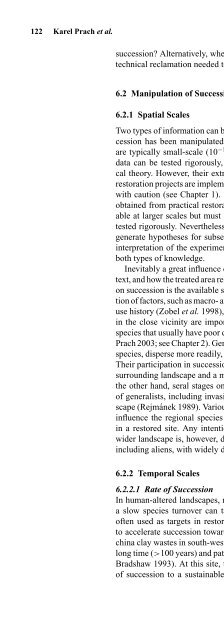Linking Restoration and Ecological Succession (Springer ... - Inecol
Linking Restoration and Ecological Succession (Springer ... - Inecol
Linking Restoration and Ecological Succession (Springer ... - Inecol
You also want an ePaper? Increase the reach of your titles
YUMPU automatically turns print PDFs into web optimized ePapers that Google loves.
122 Karel Prach et al.<br />
succession? Alternatively, when is manipulation of spontaneous succession or<br />
technical reclamation needed to reach the targets?<br />
6.2 Manipulation of <strong>Succession</strong>: A Framework<br />
6.2.1 Spatial Scales<br />
Two types of information can be obtained from restoration schemes where succession<br />
has been manipulated: The first is from controlled experiments that<br />
are typically small-scale (10−1 –102 m2 ) <strong>and</strong> last only a few years. Resulting<br />
data can be tested rigorously, <strong>and</strong> have a potential to contribute to ecological<br />
theory. However, their extrapolation to the scales at which most practical<br />
restoration projects are implemented (103 –105 m2 ) is limited, <strong>and</strong> must be made<br />
with caution (see Chapter 1). Second, there are general observations that are<br />
obtained from practical restoration work. Such information is typically available<br />
at larger scales but must also be used with caution because it cannot be<br />
tested rigorously. Nevertheless, this observational information can be used to<br />
generate hypotheses for subsequent testing <strong>and</strong> verification as well as in the<br />
interpretation of the experimental data. Each restoration project ought to use<br />
both types of knowledge.<br />
Inevitably a great influence on any restoration scheme is the l<strong>and</strong>scape context,<br />
<strong>and</strong> how the treated area relates to its surroundings. An important constraint<br />
on succession is the available species pool, which is determined by a combination<br />
of factors, such as macro- <strong>and</strong> microclimate, areas of intact vegetation, l<strong>and</strong>use<br />
history (Zobel et al. 1998), <strong>and</strong> by their spatial patterns. Propagule sources<br />
in the close vicinity are important for the establishment of late-successional<br />
species that usually have poor dispersal abilities (Poulin et al. 1999, Novák <strong>and</strong><br />
Prach 2003; see Chapter 2). Generalists, often present among early-successional<br />
species, disperse more readily, <strong>and</strong> can colonize from a distance (Grime 1979).<br />
Their participation in succession is often determined by their abundance in the<br />
surrounding l<strong>and</strong>scape <strong>and</strong> a mass effect is important (Settele et al. 1996). On<br />
the other h<strong>and</strong>, seral stages on restored sites may serve as propagule sources<br />
of generalists, including invasive aliens <strong>and</strong> weeds, for the surrounding l<strong>and</strong>scape<br />
(Rejmánek 1989). Various human activities in the surrounding l<strong>and</strong>scape<br />
influence the regional species pool <strong>and</strong> thus influence vegetation succession<br />
in a restored site. Any intentional manipulation of propagule sources in the<br />
wider l<strong>and</strong>scape is, however, difficult. This is particularly true for generalists,<br />
including aliens, with widely dispersed propagules (see Chapter 5).<br />
6.2.2 Temporal Scales<br />
6.2.2.1 Rate of <strong>Succession</strong><br />
In human-altered l<strong>and</strong>scapes, recovery to late-successional communities with<br />
a slow species turnover can take many decades, yet these communities are<br />
often used as targets in restoration programs <strong>and</strong> succession is manipulated<br />
to accelerate succession toward them. Under extreme site conditions, such as<br />
china clay wastes in south-west Engl<strong>and</strong>, unassisted succession can take a very<br />
long time (>100 years) <strong>and</strong> patches devoid of vegetation can persist (Marrs <strong>and</strong><br />
Bradshaw 1993). At this site, technical manipulations can reduce the process<br />
of succession to a sustainable ecosystem in as less as 7 years. However, in

















